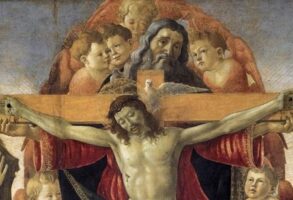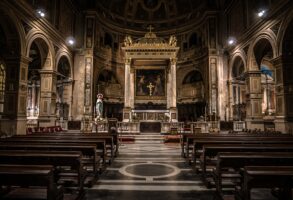
Published December 3, 2015
First Things - January 2016 issue
When the XIV Ordinary General Assembly of the Synod of Bishops opened with a concelebrated Mass at the Altar of the Confession in St. Peter’s Basilica on October 4, it was already clear that there would be three synods: the real synod, the mainstream media synod, and the blogosphere synod. The first and third would be daily affairs; the second would be more sporadic. Both participants and observers wondered what effect the second and third would have on the first.
As things turned out, the short answer to that initial puzzlement was “not much,” except by way of providing occasional amusement and aggravation. As always, the mainstream media kept looking for confirmation of its Rorschach-blot reading of Pope Francis as the long-awaited papal reformer who would adjust Catholic doctrine and practice to the zeitgeist, especially in terms of the sexual revolution. The blogosphere, dependent on the mainstream media for what it foolishly regarded as accurate information, was divided between those who enthusiastically shared these hopes for a Franciscan revolution of a liberal Protestant sort, and those who were scared to death that the enthusiasts were right about the pope from the end of the earth. So the media synod and the blogosphere synod followed their own prepackaged scripts, and were not very interesting as a result.
The actual synod, however, was another matter.
Real issues were debated, with real consequences at stake. Some of this was visible atop the froth of the mainstream media and blogosphere commentary. How would the Catholic Church settle the argument, launched by Cardinal Walter Kasper in February 2014, about its long-standing and doctrinally informed discipline of not admitting the divorced and civilly remarried to Holy Communion? And beneath that debate, other and deeper issues loomed. Perhaps the most fundamental involved the claims of revelation on the pastoral life of the Church. Did the Catholic Church still affirm the Second Vatican Council’s teaching in the Dogmatic Constitution on Divine Revelation, Dei Verbum, on the reality and binding force of divine revelation? How was revelation to be related to the signs of the times, which the Church was enjoined to read by Vatican II’s Pastoral Constitution on the Church in the Modern World, Gaudium et Spes? And how did all of that bear on the relationship between mercy and truth, between pastoral accompaniment and pastoral challenge, between one’s condition of life and one’s ability to receive the grace of the sacraments?
The fact that, for the first time in two thousand years, the Catholic Church is “catholic” (universal, global) in an existential sense put other important questions in play. How should the experience of the young churches of Africa, where the Christian idea of marriage and family is received as a liberating force, be weighed against the experience of dying churches in which divorce is as widespread as Sunday Mass attendance is not, churches whose leaders claimed before the synod that Catholicism’s teaching on divorce drives people away from God?
Then there were the issues posed by that ancient malady known as odium theologicum. Some synod fathers came to Synod 2015, as they had come to its preparatory predecessor, Synod 2014, determined to re-adjudicate Paul VI’s 1968 encyclical on the morally appropriate means of regulating fertility (Humanae Vitae) and John Paul II’s 1993 encyclical on the reform of Catholic moral theology (Veritatis Splendor). Those who wished to bury those two encyclicals were, in the main, identical with those pressing the Kasper proposal for admitting the divorced and civilly remarried to Holy Communion. Those who found the Kasper proposal woefully deficient on many grounds were, in the main, those who judged that Humanae Vitae had been prophetic in its analysis of what a “contraceptive mentality” would do to Western culture and society; who thought that Veritatis Splendor had rescued Catholic moral theology from the quicksand of postmodern subjectivism; and who believed that the “signs of the times” (pace Gaudium et Spes) should be read through the lens of divine revelation (pace Dei Verbum), rather than taken as the principal hermeneutic tool for understanding revelation today.
The contest over the Catholic Church’s response to the sexual revolution, which involves basic questions of the Church’s self-understanding and the Church’s pastoral approach to mission, will continue long past the most recent Synod on the Family. Nonetheless, the arguments abroad in Rome during the meeting, and the way the great majority of them were resolved in the final report, reinforced the doctrinal and theological foundations on which that contest must be fought, claims to the contrary from those who lost most of what they were seeking in Rome notwithstanding. To put all of that into a clearer focus than was available in October through the smog of the mainstream media and blogosphere, attention must be paid to what actually happened.
Game Changers
Long before the synod fathers began assembling in Rome, it was clear that many of them were deeply concerned about the working document (the Instrumentum Laboris, hereafter IL) they had been given. In the months after it was made available last summer, the IL was severely criticized for numerous deficiencies. The first had to do with structure: Why did an ecclesial document begin with sociology—and not very good sociology—rather than the Word of God? Shouldn’t the latter be the first thing reflected upon, so that the kaleidoscopic crisis of marriage and the family today would come into a sharper and appropriately Christian focus?
Many synod fathers also found the language of the IL dull and uninspired, as if the Church, confronted with the cultural tsunami of the sexual revolution, had run out of intellectual gas and pastoral nerve and was mildly embarrassed by its teaching—especially the teaching of Veritatis Splendor and John Paul II’s Theology of the Body, neither of which was prominently featured (to put it gently) in the IL. There were also thought to be dangerous ambiguities in its discussion of pastoral practice; on that front, more than a few episcopal eyebrows were raised by the fact that the synod general secretariat had ignored its own ground rules by inserting into the working document for Synod 2015 material that was not in the final report of Synod 2014.
In the forty-eight hours before the synod began its work, however, these concerns were superseded by grave concerns over synod process. With two days to go, it was unclear whether there would be any votes on anything at the meeting—which would have been an unprecedented change in procedure, for votes on propositions had always been the way the synod fathers made their judgments known to the Church and the world in the past. Moreover, the fathers were informed that their interventions in the synod’s general assembly would be the synod’s property and would not be made public. (The rationale offered by the general secretary was that this would foster more open debate.)
Beyond that, it seemed that the reports from the synod’s thirteen language-based discussion groups, where the serious discussions would unfold, were not going to be made public, either. And beyond even that, many believed that the drafting commission announced by Synod General Secretary Cardinal Lorenzo Baldisseri to prepare the final report (the publication of which was also in doubt) was badly skewed and did not reflect the balance of opinion among the synod fathers.
This was simply unacceptable to a large number of bishops, who were not eager to spend three weeks in a virtual lockdown from which nothing would emerge: a lockdown that treated them as appendages to the synod general secretariat and enmeshed them in a secretive process that would have caused the deepest suspicions in the Church and the world about what was afoot. These concerns found expression in a private letter given to Pope Francis at the end of the synod’s first working day (Monday, October 5), which was signed by thirteen cardinals, including three prefects of major dicasteries of the Roman Curia and ten residential archbishops from four continents.
Because the letter was a private one to the Vicar of Christ, its signatories did not believe that its contents should be made public, even after an early draft of the letter was leaked. But it can be stated as a matter of fact that the letter was entirely respectful of the pope’s person and prerogatives; that it expressed the cardinals’ concern that the pope’s call for an open and frank conversation was going to be impeded by the proposed synod process; that it requested a normal voting procedure so that the fathers could make their judgments known; that it sought greater openness in making available to the Church and the world the participants’ reflections in both the general assembly and the language-based discussion groups; and that it looked forward to a final report prepared so as to reflect the entire synod.
Two days later, most of the letter’s requests had been honored. The general secretary made it clear that the synod fathers could, if they wished, make their general assembly interventions available to the press and to their dioceses. The reports of the language-based discussion groups would be made public. There would be votes on the draft final report, paragraph by paragraph. The disposition of the report remained the prerogative of the pope, as was entirely proper, but it was assumed that the report would be made public. (Veterans of the Vatican naturally assumed that it would be leaked within twenty-four hours of its completion, in any event.)
If the cardinals’ letter transformed the process, the introduction to the Instrumentum Laboris on the first working day by the synod’s Hungarian Relator (Rapporteur-General), Cardinal Péter Erdő, was the substantive game-changer. It was anticipated that Cardinal Erdő would give three introductions, one to each of the IL’s three parts, at the beginning of each week’s work. Erdő chose instead to offer an introduction to the entire working document on the first day of the synod. In doing so, he set a solid foundation for the synod’s deliberations that effectively corrected the gross inadequacies of the IL (which by this point had been conceded by virtually everyone except the German-speaking participants and the general secretariat, which had authored it).
Cardinal Erdő began by putting the synod on a firm ecclesial footing, describing marriage and family life as vocations: institutions given by God as part of the “divine pedagogy” in which we learn the dignity of human life and human love, and the true meaning of our being made male and female. The Hungarian cardinal then looked at marriage and the family through the prism of revelation and doctrine, noting that, in the Creator’s design, the unitive and procreative dimensions of marriage were “inscribed” as truths built into us. Christ’s work of redemption, he continued, had restored within marriage and the family “the image of the Most Holy Trinity, from which springs every true love.”
Cardinal Erdő also located the Christian family in the context of John Paul II’s New Evangelization and Pope Francis’s call for a “Church permanently in mission,” reminding the synod fathers that “the missionary dimension of the family is rooted in the sacrament of Baptism, through which all are commissioned to be missionary disciples,” and from which the Christian family is constituted as a “domestic Church.” That was why the family, as St. John Paul had taught in the 1981 apostolic exhortation Familiaris Consortio, “is the way of the Church”: a point Blessed Paul VI had underscored in the encyclical Humanae Vitae, when he noted the many ways in which modern technology detached marriage from family by separating “procreation from conjugal love.” Moreover, as Benedict XVI had written in the encyclical Caritas in Veritate, “the experience of love in marriage and the family” is vital to the life of society because the family is the place where one learns the meaning of the common good through experience.
The rapporteur-general underscored that the “teaching of Christ on matrimony”—monogamy and the indissolubility of marriage—was a “true gospel and a font of joy” in which the human person realizes his or her “vocation to personal relationships” of freedom, mutual self-gift, and full acceptance of the other. The teaching on indissolubility, the cardinal noted, comes from the Gospels and St. Paul, and has always distinguished the Christian view of marriage from others’.
Thus, in the first half hour of his talk, Erdő set the discussions of Synod 2015 on a solid foundation built from the Scriptures and the magisterium of the three preceding pontificates, thereby tacitly rejecting the false premise that the fathers could start from scratch in considering marriage and the family in the twenty-first century. The signs of the times, he concurrently made clear, should be read through the lens of divine revelation.
But the Hungarian prelate wasn’t done yet.
Cardinal Erdő reminded the synod fathers that mercy and revealed truth cannot be opposed, for “merciful love, as it attracts and unites, also transforms and lifts up. It is an invitation to conversion.” In this light, “a merciful pastoral accompaniment of the divorced and civilly remarried” cannot “leave in doubt” the “truth of the indissolubility of marriage taught by Jesus Christ himself.” “The mercy of God,” he continued, “offers sinners pardon” but always “calls to conversion.”
Erdő then criticized one of the arguments being offered in favor of the Kasper proposal to admit the divorced and civilly remarried to Holy Communion at the end of a “penitential path,” but without an annulment of the first marriage. As Erdő put it, “it is not the shipwreck of the first marriage but the living-together in the second relationship that impedes access to the Eucharist.” The cardinal then pointed out a possible way forward, citing the teaching of John Paul II in Familiaris Consortio(84): When those who in conscience believe that, for the sake of their children or the common life they have built in a second marriage, they must remain in that marriage, there is access to the sacraments of penance and the Eucharist when the couple practices continence, “living their relationship as one of mutual help and friendship.” Such a requirement on the part of the Church does not, Erdő said, reduce marriage to a mere exercise in sexual expression. Rather, it recognizes the reality of the situation in light of the truth about marriage taught by Christ. There is, in other words, a true path to the sacraments for the divorced and civilly remarried and there always had been: the path of continence.
As to the question of “gradualism” in an individual’s or couple’s growth in the moral life, a concept often used as a side entry into the Kasper proposal, Cardinal Erdő said that, while we all grow in the life of grace, “between true and false, between good and evil, there is in fact no such ‘graduality.’” And although there may be “some positive aspects” to be found in irregular relationships, “this does not imply” that these relationships “can be presented as good.”
Cardinal Erdő then turned to an issue many thought would be the next step beyond the Kasper proposal: a tacit ecclesial blessing on homosexual unions. While urging respect and sensitive pastoral care for people who experience same-sex attraction, he stated flatly that “there is no foundation” in truth for making any “analogy, however remote, between homosexual unions and God’s design for marriage and the family.” The cardinal also urged the pastors of the Church to resist campaigns to affirm these new designs for building families, and stated bluntly that the pressures put on poor countries by international institutions that condition financial aid on the former’s acceptance of same-sex marriage were “unacceptable.”
The rapporteur-general’s conclusion urged the synod fathers to continue their attentive listening to the Word of God so that the Church’s response “to the needs of our contemporaries” may be one that “offers them liberating truth” in the witness of greater mercy. For his labors, the Hungarian prelate received a warm ovation, but Cardinal Kasper, who reportedly looked somewhat stunned, was not among those applauding.
Cardinal Erdő’s decision to treat the entire subject matter of the synod at the outset—which it is hard to imagine him doing without consulting the pope—effectively buried the Instrumentum Laborisas Synod 2015’s guiding document. The general assembly and small-group discussions would continue to work from the tripartite structure of the IL, but Erdő’s introductory intervention had the happy effect of liberating the synod participants. Rather than slavishly following the deeply flawed IL, they could now probe far more deeply into the Christian tradition—and into the contemporary situation of marriage and the family, which includes good news as well as bad—in order to develop and reform the Church’s pastoral response to a profound cultural and human crisis. Moreover, the Hungarian cardinal’s talk took any possible endorsement of civil unions among same-sex couples off the table while putting paid to the Kasper proposal in its initial form. And while Kasper’s allies would not throw in the towel, at the end of the synod’s first day it was much more likely that Synod 2015 would not repeat the experience of Synod 2014 and be hijacked by the preoccupations of the German-speaking fathers.
Real Debates on Deeper Issues
While the Kasper proposal in its initial form was effectively derailed by Cardinal Erdő’s introductory intervention, its proponents were nothing if not tenacious. Thus the proposal reappeared in new forms, each of which provoked important debates on deeper issues in the general assembly and in the language-based discussion groups. In each of these guises, proponents continued to claim that the whole matter of Holy Communion for the divorced and civilly remarried was not about a “change in doctrine” (which the pope had insisted was untouchable) but a “change in discipline” or a “change in pastoral practice.” That dodge got very little traction, however, not least because it was asserted rather than argued, and in any event had been thoroughly vetted (and rejected) in the run-up to Synod 2014 and in the year between the synods. So the Kasper party (largely, it should be noted, without the active participation of Cardinal Kasper, who was strikingly quiet) deployed other stratagems. And in doing so, the Kasperites ironically, and almost certainly unintentionally, contributed to a deepening of the meeting’s debates and of the Church’s understanding of the issues beneath the issues at Synod 2015.
The Kasperites’ Plan B was a variant on the Febronianism that plagued German-speaking Catholicism throughout the Enlightenment and was quickly dubbed “local-option Catholicism,” a useful tag that was widely adopted. In essence, Plan B asked the Church to reconceive itself as a federation of national churches, united symbolically by the successor of Peter, but substantially independent of each other (and Rome) doctrinally and pastorally. Thus national or continental bishops’ conferences would be empowered to find local “solutions” to the challenges posed by the contemporary crisis of marriage and the family. No one paying attention had any doubt about the direction such a devolution would take in certain quarters. In Germany, Austria, Switzerland, and Belgium, for example, the practice of offering Holy Communion to the divorced and civilly remarried is already widespread, and what was being sought was a means of affirming what is already happening (or, in the spin put on this by some German-speakers, giving the bishops a tool by which the episcopal conferences in question could get some control over the practice by establishing criteria for it).
In response, synod fathers from around the world pointed out the unhappy role that local-option ecclesiology has had in fragmenting the Anglican communion, now to the point of virtual disintegration. The even sharper theological case against the Kasperites’ Plan B was put forward by the synod fathers who argued from basic sacramental logic: It simply cannot be the case that what is sacrilege in Poland is a font of grace on the other side of the Polish-German border. That argument eventually carried the day, and another important marker was laid down—a decisive majority of the synod fathers were determined that the Catholic Church would remain one, in both doctrine and sacramental discipline.
With Plan A and Plan B off the board, Plan C was deployed, in the form of an appeal to the rights of conscience. Surely, the dogged Kasperites argued, the final arbiter of the decision on worthiness to receive Holy Communion is the individual, confronting his or her situation in the sanctuary of conscience, acknowledged as inviolable by Vatican II in its Declaration on Religious Freedom, Dignitatis Humanae. Critics quickly pointed out, however, that the Catholic Church (and Dignitatis Humanae) had never considered “conscience” a free-floating faculty of choice detached from religious and moral truth. It was true, Cardinal Thomas Collins of Toronto and others argued, that the Catechism of the Catholic Church teaches the imperative of obeying one’s conscience. But it also reminds the faithful of the imperative of having a rightly formed conscience. And the duty of the twenty-first-century pastors of the Church is, surely, to call the people of the Church beyond the expressive individualism that has reduced human beings to bundles of desires (vitiating the idea of “conscience” in the process).
The Church, these synod fathers argued, has ample resources with which to propose a richer understanding of the nobility of human choosing and the human capacity, under grace, to choose wisely and well, even in difficult circumstances, and it ought to deploy them more effectively. Blessed John Henry Newman’s Letter to the Duke of Norfolk was cited to good effect in these debates. Then Plan C was given the coup de grâce by a five-minute, six-point explication of the Catholic understanding of conscience by Cardinal Carlo Caffarra of Bologna, in a strikingly lucid general assembly intervention that was being discussed with reverence days after it was given.
The Germans being nothing if not persistent, it came down, in the end, to Plan D: Decisions on “pastoral accompaniment” of the divorced and civilly remarried should be made in the “internal forum” by a penitent and confessor. Some described this as “local-option Catholicism” taken all the way down to the parish level, a farm-to-table version of sacramental theology. Other synod fathers, less theologically alert, seemed to find in Plan D a way to be compassionate without abandoning essential Catholic doctrine—and perhaps a “solution” by which to mollify the German-speakers, who were, in the main, having a bad synod. As things finally resolved themselves, the phrase “internal forum” did make it into the synod’s final report. But it was circumscribed in a way that the proponents of Plan D obviously found disturbing, because they denied that any such hedging-about had taken place.
Pazzo Intermezzo
While these real debates about real issues were unfolding in the synod aula and the language-based discussion groups, the world media were having fits, in large part because there was no story to cover. The debates took place behind closed doors. Some bishops shared their general assembly interventions with the press, but for the most part, the gathered scribes had little to do until the discussion groups’ reports began to be released days after the synod opened. Thus the press was reduced to what the Boston Globe’s John Allen accurately described as reporting on what others said was happening in the synod (or even reporting on reporting on what others said was happening at the synod), rather than reporting on what was actually happening.
This led to the usual fantasies and distortions in the Italian media, which too many gullible Anglophone journalists take seriously and then refract, undistilled, into the Anglosphere. But as usual during large-scale Catholic events at the Vatican, the Italian press had more than its elbow up its sleeve, and there was a lot more going on in Italian coverage of the synod than coverage of the synod. There was pre-conclave politicking, inevitable with a pope about to turn seventy-nine. And then there was the traditional score-settling and agenda-agitating, these not infrequently involving the financial reforms that Cardinal George Pell had put in place over the last year and a half with the firm support of Pope Francis.
That Pell was a leader among the challengers to the Kasper proposal in its sundry iterations afforded the Australian cardinal’s critics and enemies an opportunity: use the synod debates as a blind behind which to take potshots at him, suggesting that he was disrespectful of the pope or even disloyal to the man who had appointed him to clean out the Augean stables of Vatican finance. The goal was to whittle down Pell, a large figure in every way (and, for the sake of full disclosure, an old friend), to the point where his further excavations into the darker corners of financial incompetence (and worse) in the Holy See would be impeded and perhaps even halted, thus sparing embarrassment (and worse) to favored leakers, patrons, or both.
These two dynamics—the lack of news and Italianate journalists’ game-playing to protect favored Vatican sources—came together in what was the most hilariously off-base piece written during Synod 2015. The article, by Paolo Rodari, sprawled over two pages of the October 14 issue of La Repubblica and set a new standard for fantasy wedded to malice.
Pell was cast as one of the leading figures in a plot by the “Rigoristi” to block Pope Francis’s pastoral initiatives, the other principal villains being Cardinals Gerhard Müller of the Congregation for the Doctrine of the Faith, Timothy Dolan of New York, Robert Sarah of the Congregation for Divine Worship, Wilfred Napier of Durban, South Africa, and the aforementioned Carlo Caffarra. The plot, Rodari wrote, was headquartered at the Pontifical North American College, was financed by the Knights of Columbus, and had ominous links to former vice president Dick Cheney, Halliburton, and the American Enterprise Institute—and, through Cheney’s wife, Lynne, to the merchants of death at Lockheed Martin.
Opposing this unholy cabal were the “Progressisti.” And here, Paolo Rodari’s fevered imagination really went into overdrive. For alongside such obvious champions of “progress” as Cardinals Walter Kasper, Reinhard Marx, and Godfried Danneels, Rodari included Archbishop Charles Chaput of Philadelphia, who was being lambasted almost daily in the progressive U.S. Catholic press and blogosphere, for whom he embodies the utter antithesis of everything “progressive.”
Chaput was vindicated ten days later, when he received one of the highest numbers of votes for election to the synod’s permanent council. Paolo Rodari and La Repubblica, for their part, gave synod participants and knowledgeable observers some good laughs, even as this intermezzo of serious craziness further illustrated a basic tenet of Vaticanology 101: There is no fixed border between fact and fiction in Italian journalism but only a membrane across which all sorts of material, some of it in the form of waste, flows.
End-Game and Final Report
The synod fathers were given the draft final report on the afternoon of Thursday, October 22 (the liturgical memorial of St. John Paul II). The draft was available in Italian only. And thanks to a change of schedule that could be plausibly interpreted as an attempt to constrain the fathers’ ability to mount serious criticisms of the draft, the synod’s members had only twelve hours to study the draft, decide what comments they wished to make on it at the general assembly on Friday morning, October 23, and formulate the modi (amendments) they would submit in writing that morning. Then, the drafting committee was to get back to work Friday afternoon to prepare the amended text that would be voted on, paragraph by paragraph, on Saturday.
Despite the truncated schedule, more than a few synod fathers were pleasantly surprised by the draft they received on October 22. The Instrumentum Laboris had been essentially jettisoned as the basis for the final report, and the draft was far richer biblically, and far more elegantly written, than anything that had previously issued from the synod general secretariat (which led to speculations about its real authorship, the drafting committee being more or less in the pocket of the synod general secretariat). Be that as it may, one synod father went so far as to observe Thursday night that, had the draft final report been the synod’s working document, the whole process would have been far more intellectually satisfying, and far more conducive to fostering the kind of discussion for which the pope had called.
But there were problems, and they centered around three paragraphs in the draft final report: 84, 85, and 86. Interventions were sketched out and more than two dozen modi were prepared to remedy the perceived ambiguities in language on the nature and direction of pastoral care of the divorced and civilly remarried. Given the lateness of the hour, so to speak, many of the modi submitted Friday morning, and more than twenty oral interventions on Friday, proposed dropping one, two, or all three of the unsatisfactory paragraphs, rather than attempting to amend them. An effort was also made to have the final report quote the crucial paragraph 84 of Familiaris Consortio in full, rather than in bowdlerized form.
In the event, those interventions and modi were largely ignored, with one crucial exception. The revised draft on which the synod fathers voted Saturday afternoon anchored paragraph 85’s discussion of the “internal forum” in the Church’s tradition: Such pastoral discernment between penitent and priest was to be undertaken “according to the teaching of the Church,” a phrase inserted between the Friday debates and the Saturday vote. Some fathers nonetheless regarded the paragraph as insufficiently precise, and came within a handful of votes of denying it the two-thirds approval needed for inclusion in the final report.
Imperfections and ambiguities notwithstanding, the final report was a massive improvement over the Instrumentum Laboris, and illustrated just how significantly the cardinals’ letter, Erdő’s introductory intervention, and the debates in the general assembly and the language groups had changed both the dynamics and the content of Synod 2015.
The final report was an unmistakably ecclesial text, a product of the Church’s meditation on the Word of God, understood as the lens through which the Church interprets the signs of the times; and while the working document was biblically anorexic, the final report was richly, even eloquently, biblical, thereby vindicating Dei Verbum a few weeks before the fiftieth anniversary of its promulgation.
The working document’s seeming embarrassment over Catholic teaching on chastity, fidelity, and worthiness to receive Holy Communion was replaced by an impressive reaffirmation of the possibility of living virtuously in the postmodern world. At the same time, the report called the Church to a more effective proclamation of the truths it bears as a patrimony from the Lord Jesus himself, and to more solicitous pastoral care of those in difficult marital and familial circumstances.
Children were largely missing from the IL. By contrast, the final report describes children as a great blessing, praises large families, is careful to honor children with special needs, and lifts up the witness of happily and fruitfully married couples and their kids as agents of evangelization.
The working document’s confused discussion of conscience was replaced by a far more serious explication of the Church’s understanding of conscience’s relationship to truth, as the final report rejected the idea that the “inviolability” of conscience amounts to a moral “get out of jail free” card.
The working document was full of ambiguities about the relationship of pastoral practice to doctrine. The final report makes clear that these two realities are closely linked in the life of the Catholic Church. Authentic pastoral care must begin from a commitment to the settled teaching of the Church, and there is no such thing as “local-option Catholicism.”
The working document was also ambiguous in describing the “family.” The final report underscores that there can be no proper analogy drawn between the Catholic understanding of “marriage” and “family” and other social arrangements, no matter what their legal status.
Mercy and truth were sometimes put in tension in the working document. The final report is far more theologically developed in relating mercy and truth in God, which means that mercy and truth are inseparable in the doctrine and practice of the Church.
The working document was dull and dispiriting. The final report, when available in the major world languages, will enrich the lives of those who read it, whatever their disagreement with this or that formulation in it.
In sum, the final report, though not without flaws, goes a very long way—and light years beyond theInstrumentum Laboris—in lifting up and celebrating the Catholic vision of marriage and the family as a luminous answer to the crisis of those institutions in the twenty-first century. And, claims to the contrary notwithstanding, the final report says not a single word about admitting the divorced and civilly remarried to Holy Communion, absent a decree of nullity.
And Next?
The election of Archbishop Chaput and Cardinals Pell, Sarah, Napier, and Marc Ouellet to the synod’s permanent council ensures that there will be strong voices pressing for an improved synod process in the future. Virtually everyone except the current synod managers agrees, for example, that there should be real exchange and debate in the general assemblies, something that requires immediate translation of interventions and texts into the major world languages. Moreover, the XIV Ordinary General Assembly of the Synod of Bishops demonstrated that the elected representatives of the national bishops conferences will not be treated as schoolchildren by the synod managers, who are their servants, not their masters. Both of these developments bode well for the future of “synodality” in the Catholic Church. Nevertheless, Synod 2015 also revealed fault lines in the Church that can no longer be denied.
The synod demonstrated what has been known, if rarely spoken of publicly, for some years: Much of the Church in northern Europe is in a de facto state of schism, not formally detached from Rome and the rest of the world Church, but thinking and living its own ecclesial reality. Some northern European bishops manifestly do not believe and teach what the Catholic Church believes and teaches. German ecclesiology at the ground level is in such a shambles that those who decline to pay the state-collected Kirchensteuer (church tax) can be denied Holy Communion and access to the other sacraments, while those living in irregular relationships are regularly offered Holy Communion. Addressing this de facto (but not de jure) separation of northern European Catholicism from the unity of the world Church—a sad byproduct of intellectual confusions and intellectual arrogance leading to massive pastoral failure—is a serious issue for the Catholic future.
The experience of Synod 2015 also suggests that too many of the Church’s bishops have a tenuous grasp on doctrine and a palpable disinclination to discuss grave pastoral matters in their appropriately theological context. Pastorally skillful bishops are, obviously, an imperative. But we are in a moment of cultural crisis in the West. Bad ideas underwrite ideologies that make war on human nature, especially male-female complementarity, and deconstruct the basic norms and institutions that promote human flourishing (often deploying coercive state power to accelerate the deconstruction). Surely the Church can find pastorally skilled and humanly compelling men who can meet the challenge of those desperately deficient ideas, which are magnifying the sum total of human unhappiness—intellectually sophisticated pastors who can invite the walking wounded of postmodernity to the joy of conversion.
The American Catholic experience of the past four decades is still not sufficiently “in play” in the deliberations of the world Church. There are a lot of things wrong with Catholicism in the United States. But the Church in the U.S. has learned some things about deploying resources such as Familiaris Consortio and the Theology of the Body in catechesis and marriage preparation that remain wholly unlearned, it seems, in other local churches in the developed world and throughout Latin America. Some of what has been learned in these pastoral and catechetical successes was put in play at Synod 2015; much more could be done in future gatherings of this sort.
The evangelical task of the Church continues, of course, irrespective of what happens at synods. Had it gone a different way, Synod 2015 might have impeded that work in the liveliest and most vital parts of the world Church. But for all the confusions caused by ignorant, irresponsible, and ideologically skewed reporting on what happened in Rome, the recent synod reaffirmed the Gospel and the settled truths of Catholic faith and practice. Those who are doing the work of the New Evangelization can take encouragement from that, and get on with living the missionary discipleship to which they were called in baptism.
George Weigel is Distinguished Senior Fellow of Washington’s Ethics and Public Policy Center, where he holds the William E. Simon Chair in Catholic Studies.









